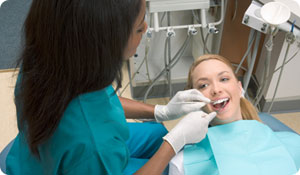
Poll your friends about what physical characteristics they find most attractive. The majority will include a "nice smile" at the top of the list. While a set of pearly whites is certainly aesthetically pleasing, poor oral health can put you at risk for a variety of chronic conditions.
According to the University of Maryland Medical Center, periodontal disease, or gum disease, is linked with type 1 and type 2 diabetes and osteoporosis. What's more, the Journal of Periodontology confirmed findings that people with periodontal disease are at a greater risk of cardiovascular and respiratory disease. The most alarming fact: more than 75 percent of American adults have some form of gum disease.
Maintenance is Key
Ensuring your smile remains healthy and intact is a matter of managing your day-to-day care. By following the tips below you'll provide your teeth with the TLC they deserve:
1. Brush your teeth twice a day. Yes, it may sound obvious. But not everyone follows the American Dental Association's (ADA) recommendation that brushing should take place twice a day and with an ADA-accepted fluoride toothpaste.
2. Brush properly. To get your chompers as clean as can be, follow the ADA recommended method:
- Place your toothbrush at a 45 degree angle against the gums.
- Move the brush back and forth gently in short strokes.
- Brush the outer tooth surfaces, the inner tooth surfaces, and the chewing surfaces of the teeth.
- Use the "toe" of the brush to clean the inside surfaces of the front teeth, using a gentle up-and-down stroke.
- Brush your tongue to remove bacteria and freshen your breath.
3. Floss. Again, something your dentist has told you over and over; however, few Americans actually do it. Decay-causing bacteria still remains between teeth where the toothbrush cannot reach. Using floss or an interdental cleaner will help remove bacteria, food particles, and plaque that linger under the gum line.
4. Clean and replace your equipment. If possible, store your toothbrush in the upright position and allow to air dry before using. Try not to cover your toothbrush. Keeping it in a case will only promote bacterial growth. After three months of use, replace.
5. Quit smoking. Smoking plays a significant role in many cases of chronic gum disease. For smokers, quitting is one of the most important steps toward regaining peak oral health.
6. Watch your diet. Sugar has always been billed as a tooth's worst enemy. Though true, it's not the whole story. Foods and juices high in acid can also cause enamel erosion, which can weaken teeth and cause cavities.
7. Visit your dentist. Gingivitis can be a silent disease. Many people have it yet remain totally unaware. By visiting your dentist one or twice a year, you can address and prevent any pressing issues.
Tooth care is more than a cosmetic endeavor. Ensuring your oral health also works to prevent structural damage as well as chronic conditions, such as diabetes and respiratory and cardiovascular disease. If you have any questions concerning your current oral health practices, consult your dentist.
Sources:
American Dental Association
http://www.ada.org/
University of Maryland Medical Center
http://www.umm.edu/





